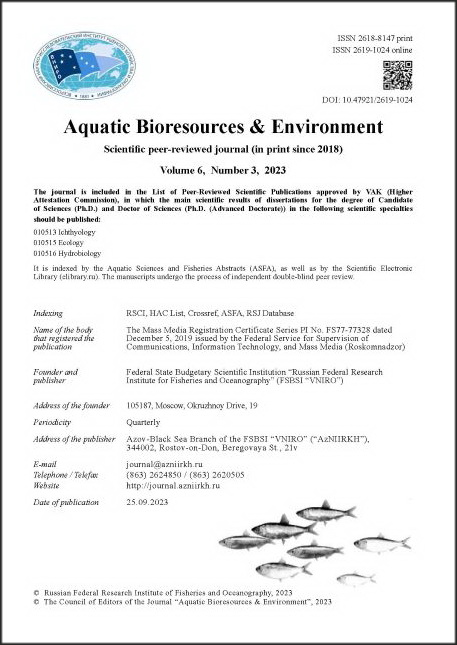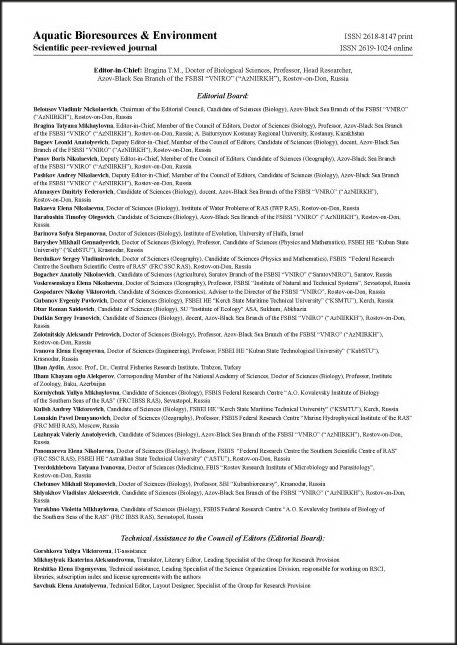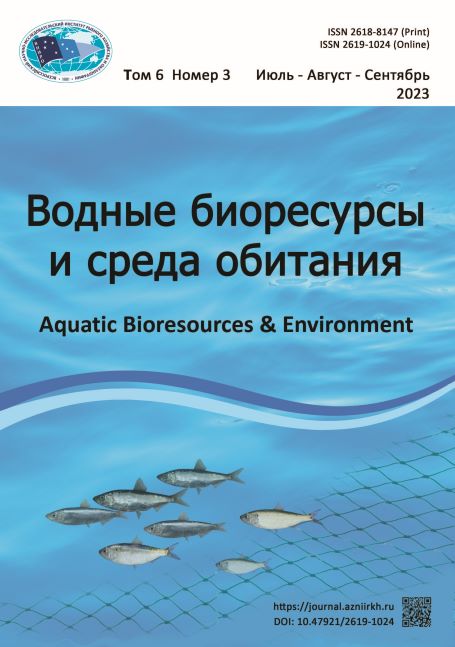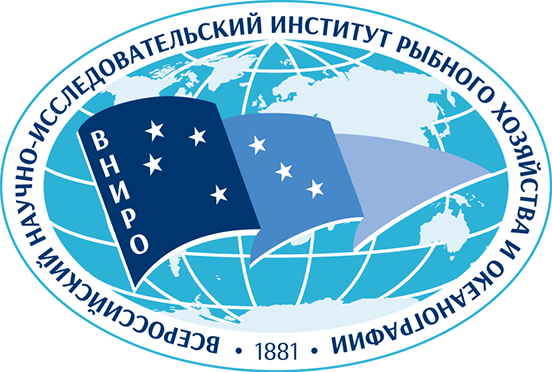Volume 6. Number 3


Environmental Concerns and the State of Aquatic Environment
Macrophytes of the genus Potamogeton as the bioindicators for the accumulation of heavy metals
A.S.Kuanova, N.V.Litvinova, T.S.Ershova, V.F.Zaytsev, N.G.Shaboyants
Abstract. This work presents the investigation of the content of some heavy metals in the pondweeds of the Lower Volga River Delta within the area of Astrakhan State Biosphere Reserve. Higher aquatic plants extract chemical elements both from bottom sediments and water column. Moreover, the macrophytes, namely the representatives of Potamogeton genus, are capable of extraction and accumulation of the metals dissolved in the water, contained in the suspended colloidal particles, and present on the surface of leaves. This work is aimed at the identification of species-specific features of the typical hydatophytes—aquatic plants of Potamogeton genus—pertaining to the accumulation of heavy metals. The content of chemical elements in the investigated specimens has been identified using atomic absorption spectrometry; the results have been processed with statistical methods. It has been found that all investigated plant species accumulate iron and manganese in the highest quantities and cobalt and cadmium in the lowest. The investigated pondweed species have shown species-specific properties in the accumulation of chemical elements. Potamogeton crispus and Potamogeton lucens are found to be iron concentrating species. Potamogeton lucens also accumulates nickel, iron and manganese, and Potamogeton pectinatus accumulates chrome, cobalt and lead.
Keywords: macrophytes, accumulation bioindicators, accumulation, heavy metals, aquatic ecosystems, biomonitoring, Volga River Delta
Yu.S.Tkachenko, E.A.Tikhonova
Abstract. The surface layer (0–5 cm) of the bottom sediments, which samples were collected during the expedition of the RV “Academician Boris Petrov” in the Northeastern Kara Sea in the summer of 2022, has been investigated. Data on the content and composition of hydrocarbons (HCs) in the bottom sediments of the investigated aquatic area have been obtained. Since oil and petroleum products are among the most common sources of pollution of the seas and oceans, it is necessary to conduct regular surveys of marine ecosystems. This work is aimed at a qualitative and quantitative assessment of HCs in the bottom sediments of the Northeastern Kara Sea and identification of their possible sources. Examination of the qualitative and quantitative composition of HCs was carried out by gas chromatography using the gas chromatograph “Crystal-5000.2” with a flame ionization detector. The quantitative determination of the total HC content was conducted by the method of absolute calibration of the FID using a mixture of HCs prepared by the gravimetric method. Chromatec Analytic 3.0 software was used to process the results. It has been found that the total amount of HCs in the bottom sediments of the Northeastern Kara Sea ranged from 25.8 to
152.4 mg/kg, being 68.21±7.76 mg/kg on average. Based on analysis of the chromatograms, the predominance of high-molecular fractions has been identified; the maximum distribution of n-alkanes was represented by homologous compounds n-C25–C29, which are the markers of allochthonous organic matter. After comparison with the calculated diagnostic indices (CPI1, CPI2, ACL, LWH/HWH, TAR, C31/C29, Paq, TMD, ΣC25–35/ΣC15–21, Pr/Ph), it was found that the increased concentrations of HCs mainly result from the natural processes and prevalence of allochthonous organic matter in bottom sediments.
Keywords: hydrocarbons, diagnostic indices, bottom sediments, Kara Sea
Biology and Ecology of Aquatic Organisms
V.V.Proskurina, A.V.Menkova, E.A.Voronina, S.A.Dyakova, A.E.Lakhtina
Abstract. Recreational and artisanal fishing is very widespread in the Astrakhan Region; its primary targets are cyprinids, which are susceptible to epedemiological threats. Food products derived from the biological resources harvested during such fishing are not subjected to the processing in specialized facilities, and therefore, safety of the final product for its consumer cannot be ensured. In this region, the diseases, the agents of which are transmitted through fish and the products of its processing, are annually recorded among the population. Sanitary and parasitological control is one of the components in the set of measures for the prevention of these diseases. This work was aimed at evaluation of the infection level in some species of commercially valuable cyprinids in the Lower Volga River Delta with bacteria and larvae of pathogenic helminths capable of causing the development of diseases in humans. An incomplete helminthological survey of Caspian roach, common bream, white bream, crucian carp and rudd, as well as microbiological examination of their muscle tissue have been carried out in accordance with the requirements of the regulatory documents currently in force with application of methods described in State Standards. Larvae belonging to four species of human-pathogenic parasites have been recorded in the parasitic fauna of the Caspian roach, rudd, and white bream. Common bream was infected by larvae belonging to two species of such helminths. The identified larvae of pathogenic trematodes and nematodes were viable. The level of bacterial contamination of fish muscle tissues did not exceed the standard-prescribed limit, and the sanitary indicator microorganisms were absent. The results of the parasitological study indicated the need for mandatory disinfection of cyprinid fish from larvae of pathogenic helminths.
Keywords: cyprinids, infestation, invasion, helminths, larvae, pathogenicity, bacteria, contamination
Energy metabolism of Mytilus galloprovincialis under low seawater pH
O.Yu. Vyalova
Abstract. The problem of acidification of the World Ocean and predicting the consequences for its inhabitants is becoming more and more relevant every year. The effect of short-term pH fluctuations in coastal ecosystems on the physiology of calcifying organisms—bivalves—remains poorly understood. The energy metabolism of the Black Sea mussel Mytilus galloprovincialis was investigated for the marine environment in a wide pH range, from 8.2 to 6.65. Lowering the pH to 7.0–7.5 led to a 20–25 % reduction in oxygen consumption by molluscs. At lower pH (6.54–6.7), aerobic respiration sharply decreased by 85– 90 %, down to the minimum values (2.12–2.62 µgO2/g dry/h), and the organisms transitioned to anaerobic metabolism. The metabolic response of the mussels subjected to short-term pH changes (8.2→6.65→7.2) has been investigated. The oxygen consumption of molluscs exposed at the same pH of 7.2 depended on the direction of the change in pH. Thus, in the case of pH 6.65→7.2, the respiration intensity was 30 % higher compared to the values obtained under the acidification pH 8.2→7.2. The Black Sea mussel
M. galloprovincialis is shown to have the capacity for survival in the marine environment characterized by the rapid fluctuations in pH that occur during the upwelling events in the coastal areas of the Black Sea.
Keywords: mussels, Mytilus galloprovincialis, respiration, pH, acidification, the Black Sea
Long-term variability of oceanic zooplankton biomass
S.A.Piontkovski, I.A.Minsky, Ya.V. Meger
Abstract. Numerous scientific publications are dedicated to the analysis of long-term variability of zooplankton biomass in oceanic and neritic zones of the World Ocean. The number of these publications keeps growing with the availability of new data. Relevance of this research can be attributed to the crucial role of zooplankton biomass in the spatio-temporal and trophic structure of aquatic ecosystems. Inter-annual fluctuations of zooplankton biomass affect the catch volumes of small pelagic fish. This research is aimed at identification of statistically valid long-term trends of the World Ocean zooplankton biomass, which involves the analysis of the data from databases and published articles describing such variability. Regional and international databases (namely COPEPOD, HOT, JGOFS, ODATE and others), which are available in the form of CDs, archived materials, and online, have been used. For the time series of the biomass across 21 areas of the World Ocean (Pacific, Indian, Atlantic Oceans and internal seas), the regression analysis has been conducted, which made it possible to estimate the parameters of linear monotonic trends. Based on bivariate spatial autocorrelation functions, the areas within which the trends are statistically homogeneous have been identified. A comparative study of long-term variability of zooplankton biomass, phytoplankton biomass, primary production, and the total live biomass of the pelagic World Ocean is presented. It is shown that the spatial distribution of positive, negative and neutral trends of zooplankton biomass on the World Ocean scale is heterogeneous. The negative monotonic trends of zooplankton biomass are found to be prevailing (in 1980–2010s); the regression parameters describing them are presented.
Keywords: inter-annual variability, World Ocean, zooplankton, phytoplankton
Hydrobiological communities of the middle reaches of the Lena River
L.I.Sidorova, E.S.Gorokhova, Y.N.Kolodeznikova
Abstract. The investigated site is located within the area of the Yakutsk Urban District and subjected to a high anthropogenic load. The construction of a bridge over the Lena River at its middle reaches is crucial for transport accessibility but will have a negative impact on aquatic bioresources and their habitat. Previously, this section of the river has not been studied, so the results will be indicative of the current state of aquatic biological resources and their habitat. This factor determined the aim of this study: the status assessment of the hydrobionts inhabiting a localized area in the middle reaches of the Lena River. The hydrochemical analysis of water samples has been carried out in the laboratory of the Republican Center for Information, Analysis and Environmental Monitoring (State Budgetary Institution “RIATSEM”); collection and laboratory processing of zooplankton and zoobenthos samples have been conducted according to generally accepted methods. The hydrochemical composition and dissolved gases of the aquatic environment in the localized section of the Middle Lena River in the vicinity of the bridge crossing are favorable for the development of organic life. Zooplankton is represented by 54 species, more than a half of which is comprised by rotifers (52 %). The average biomass of zooplankton in the spring and summer seasons was 1.135 g/m3; in the autumn and winter seasons it was 0.057 g/m3, and the average annual value was
0.238 g/m3. Crustaceans have the highest share in the biomass, and rotifers are the most abundant.
Zoobenthic organisms are represented by 9 groups; oligochaetes and chironomid larvae prevail throughout the year. The average biomass of the zoobenthos in the area along the shore was 37.41 g/m2; in the auxiliary streams it was 174.84 g/m2, and in the main course it was 3.52 g/m2. Following the results of this study, the qualitative and quantitative characteristics of the invertebrates have been found to be indicative of a favorable state of their habitat.
Keywords: Lena River, ecology, zooplankton, zoobenthos
Ichthyofauna of Marine and Inland Water Bodies
Characterization of the beluga breeding practices at the Don Sturgeon Hatchery
O.A.Vorobyeva, E.V.Gorbenko, S.G.Sergeeva, A.A.Pavlyuk, V.N.Khorosheltseva
Abstract. The study conducted in 2022 has identified a lack of consistency in the results of the beluga artificial reproduction at the Don Sturgeon Hatchery (DSH). To obtain eggs, mostly the females born in 2001–2004 were used, out of which 31 females at age 18 reached their first maturity and one female at age 21 was a repeat spawner. The majority of first-spawning females produced eggs of low quality. During incubation, there was a substantial loss of fertilized eggs, and various anomalies of embryonic development were observed, which necessitated termination of the incubation of such eggs. The yield of one-day larvae from the eggs obtained from the first-spawning females and set for incubation was low, around 12 %. One of the reasons for the increased mortality rates and development anomalies in the larvae was low quality of the oocytes in the first-spawning individuals. A second-spawning female has shown satisfactory results; the fertilization rate was in line with the standard values, and no more than 17 % of the eggs manifested embryonic anomalies during their incubation. The yield of one-day larvae was
53.3 %. In total, 799 thousand one-day beluga larvae were obtained. The analysis of the cultivation practices at the Don Sturgeon Hatchery made it possible to identify the bottleneck points and critical junctures at some stages of the biotechnological process, as well as to give recommendations on improvement of the hatchery operation. An important prerequisite for obtaining good results is the physiological adequacy of beluga females, which is based, for the most part, on the living environment and feeding quality of the breeders and their replacement in the broodstock.
Keywords: beluga Huso huso (Linnaeus, 1758), broodstock, eggs, reproductive function, hormonal stimulation, incubation, anomalies of embryonic development
B.G.Kotegov
Abstract. In the middle rivers of the Udmurt Republic, fish were caught near the sampling stations for the state environmental monitoring. The fluctuating asymmetry (FA) of the pore number of the seismosensory canals in the dermal head bones of the roach, Rutilus rutilus (L.), which prevailed in the catches, was estimated using osteological analysis. Its indicators in the roach individuals caught in the different river sections have been collated with the values of specific combinatorial water pollution index (SCWPI) of the examined sections and with the average concentrations of some pollutants in water in late spring and early summer for the several years preceding the years of catching. A statistically significant trend forthe increase in the FA variance (S 2), calculated on the basis of the total number of pores in the head seismosensory system of the roach, with the increase in the SCWPI and the content of some anions (chlorides, nitrites, nitrates) in the river water of its habitats has been identified. The highest S 2 was observed in the roach individuals caught in the Izh River dowstream from Izhevsk in the environment, severely polluted by municipal wastewater, while the lowest one was recorded in the Kilmez River, the least polluted by wastewaters. No significant relationships between the FA indicators in this fish species and the content of heavy metals or other pollutants in the middle rivers of Udmurtia have been revealed. These results are considered to be attributable to a decrease in stability of morphogenesis in the fish organisms that developed under non-optimal (stressful) hydrochemical conditions.
Keywords: roach, Rutilus rutilus, fluctuating asymmetry, seismosensory system, middle rivers, Udmurt Republic, chemical pollution
Stock assessment of the marine fish species in the Black Sea (Russian waters) in 2021
V.A.Shlyakhov, M.M. Piatinskii
Abstract. Based on the available biological and fisheries data, stock status review for 18 units of the fish species inhabiting the Black Sea and the both Azov and Black Seas is presented. A modified version of the traditional approach to the harvest control rules for the aquatic bioresources of the Azov and Black Sea Fishery Basin is described for the case when they are assessed by the mathematical methods to estimate the current stock biomass and fishing mortality. For 11 stock units, analytical modeling including cohort, production and trend models has been applied. Based on the estimates of biomass and fishing mortality concerning biological reference points, in 2021, the status of six stock units of the marine fish species inhabiting the basin and exploited by the Russian fisheries was identified as increasing or stable (“Black Sea” stock units of the European sprat and European anchovy, “Crimean” stock unit of turbot, “Crimean and Caucasian” stock unit of red mullet, and “Black and Azov Seas” stock units of garfish and rays). Five fishery stock units (“Crimean and Caucasian” of mullets, picarel and Mediterranean horse mackerel, “Black and Azov Seas” of sand smelts, and “Caucasian” of turbot) have shown a decreasing trend in terms of abundance, and for the rest of the investigated fish stock units (“Mediterranean migrant” bluefish, Atlantic bonito and Atlantic mackerel, “Black Sea” whiting, so-iuy mullet and the other marine fish species, “Black and Azov Seas” spiny dogfish), the status has not been determined due to the absence of systematic biological and fishery data.
Keywords: stock status, harvest control rules, biomass, fishing mortality, biological reference points, pelagic and demersal fish species, Black Sea, Azov Sea
Informational Messages
On the fifth anniversary of the scientific peer-reviewed journal “Aquatic Bioresources & Environment”
T.M.Bragina, E.A.Mikhailyuk, E.E.Reshitko, E.A.Savchuk
Abstract. The scientific peer-reviewed journal “Aquatic Bioresources & Environtment” has been published since 2018 and functions as a discussion platform for researchers and practitioners of the vast fishery region (mainly the Southern Russia). In July 2023, the journal celebrated its fifth anniversary. The aim of this article is to review the notable milestones of the formation of the journal as a scientific publication from its first issue up to the present moment. Currently, the journal is included in the List of peer-reviewed scientific publications, in which the main scientific results of dissertations for the degree of Candidate of Science and for the degree of Doctor of Science should be published (List of the Higher Attestation Commission), and is abstracted in the International Information System for Aquatic Sciences and Fisheries Abstracts (ASFA) and the Scientific Electronic Library e-library.ru (eLIBRARY), as well as indexed in the Russian Science Citation Index (RSCI). Articles in the journal are assigned with Digital Object Identifiers (DOI), which are registered by the international agency Crossref; they are posted on the journal's website and added to RSCI and other databases.
Keywords: scientific journal “Aquatic Bioresources & Environment”, history of creation, current status



